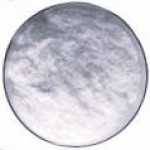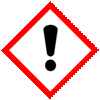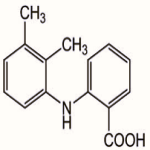CAS Number 61-68-7, Mefenamic Acid BP Ph Eur IP EP USP JP Grade Manufacturers Exporters







CAS Number 61-68-7, Mefenamic Acid BP Ph Eur IP EP USP JP Manufacturer Exporter
For Properties Specifications of Mefenamic Acid Click Properties, Specifications of Mefenamic Acid Manufacturer.
For Uses of Mefenamic Acid Click Uses of Mefenamic Acid Manufacturer.
For For SDS MSDS Sheet of Mefenamic Acid Click SDS Safety Data Sheet MSDS Sheet of Mefenamic Acid Manufacturer.
The Properties and Specifications of Mefenamic Acid:
Mefenamic Acid BP Ph Eur Grade Specifications:
C15H15NO2 --- 241.3 CAS 61-68-7
Action and use: Cyao-oxygenase Inhibitor, anargeric anti-inflammatory.
DEFINITION
2-[(2,3-Dimethylphenyl)amino]benzoic acid.
Content: 99.0 per cent to 101.0 per cent (dried substance).
CHARACTERS
Appearance: White or almost white, microcrystalline powder.
Solubility: Practically insoluble in water, slightly soluble in ethanol (96 per cent) and in methylene chloride. It dissolves in dilute solutions of alkali hydroxides. It shows polymorphism.
IDENTIFICATION
Infrared absorption spectrophotometry.
TESTS
Related substances: To pass the test by Liquid chromatography.
Copper: Maximum 10 ppm.
Loss on drying: Maximum 0.5 per cent, determined on 1.000 g by drying in an oven at 105C.
Sulfated ash: Maximum 0.1 per cent, determined on 1.0 g.
Mefenamic Acid USP Grade Specifications:
C15H15NO2 --- 241.29
Benzoic acid, 2-(2,3-dimethylphenyl)amino-.
N-2,3-Xylylanthranilic acid CAS 61-68-7
UNII: 367589PJ2C
Mefenamic Acid contains not less than 98.0 percent and not more than 102.0 percent of C15H15NO2, calculated on the dried basis.
Identification:
A: Infrared Absorption.
B: The retention time of the major peak in the chromatogram of the Assay preparation corresponds to that in the chromatogram of the Standard preparation, as obtained in the Assay.
Loss on drying: Dry it at 105C for 4 hours: it loses not more than 1.0% of its weight.
Residue on ignition: not more than 0.1%.
We also manufacture Mefenamic Acid IP EP JP Grade.
The Uses of Mefenamic Acid:
Mefenamic acid is used to relieve mild to moderate pain, including menstrual pain.
The MSDS-SDS Hazard Statement of Mefenamic Acid:
Mefenamic Acid SDS, Safety Data Sheet
MSDS Sheet, Material Safety Data Sheet 19-Nov-24
1. Product Identification
Product Name/Synonyms: Mefenamic Acid.
CAS No.: 61-68-7
EINECS EC Number: 200-513-1
Relevant uses and uses advised against (if any): Industrial Manufacturing.
Suppliers: As per letterhead.
2. Hazards Identification
GHS, Globally Harmonized System Classification in accordance with 29 CFR 1910
Classification according to Regulation (EC) No 1272/2008
Acute toxicity, oral Category 4
Labeling according to Regulation (EC) No 1272/2008
GHS Label Elements  Harmful |
Signal Words: Warning
Hazard statements:
H302: Harmful if swallowed.
Precautionary statements:
P262: Do not get in eyes, on skin, or on clothing.
P264: Wash skin thoroughly after handling.
P280: Wear protective gloves/protective clothing/eye protection/face protection.
P270: Do not eat, drink or smoke when using this product.
P301+312: IF SWALLOWED: Call a POISON CENTER or doctor/physician if you feel unwell.
P332+313: If skin irritation occurs: Get medical advice/attention.
P302+P352: IF ON SKIN: Wash with plenty of soap and water.
P305+P351+P338 IF IN EYES: Rinse cautiously with water for several minutes. Remove contact lenses, if present and easy to do. Continue rinsing.
P337+P313: If eye irritation persists: Get medical advice/ attention.
3. Composition/Information on Ingredients
Product Name/Synonyms: Mefenamic Acid.
CAS No.: 61-68-7
EINECS EC Number: 200-513-1
4. First Aid Measures
Inhalation: Remove to fresh air. Give oxygen if breathing is difficult; give artificial respiration if breathing has stopped. Keep person warm and quiet; get medical attention.
Ingestion: Induce vomiting immediately as directed by medical personnel. Never give anything by mouth to an unconscious person.
Skin Contact: Immediately flush skin with plenty of soap and water for at least 15 minutes. Remove contaminated clothing and shoes.
Eye Contact: Immediately flush eyes with plenty of water for at least 15 minutes, lifting upper and lower eyelids occasionally. Get medical attention.
5. Fire Fighting Measures
Fire: It is not considered to be a fire hazard. However, it will burn at high temperature.
Fire Extinguishing Media: Use water spray, alcohol-resistant foam, dry chemical, or carbon dioxide. Avoid solid water jets as it can scater the fire. Use water spray to cool fire-exposed containers.
Special hazards arising from the substance or mixture: Carbon oxides, Nitrogen oxides (NOx), Fumes.
Special Information: In the event of a fire, wear full protective clothing approved self-contained breathing apparatus with full face piece.
6. Accidental Release Measures
Personal precautions, protective equipment, and emergency procedures: Use personal protective equipment. Ventilate area of leak or spill. Avoid breathing dust/fumes/gas/mist/vapors/spray. Use individual protective equipment (waterproof boots, suitable protective clothing, safety glasses, etc.).
Environmental precautions: Do not let the product enter drains, soil, or water sources.
Methods and materials used for containment cleanup procedures and Storage: Contain spilled material. Pick up spills and place them in a suitable container for reclamation.
7. Handling and Storage
Precautions for safe handling: Apply according to good manufacturing and industrial hygiene practices. Ensure proper ventilation. Wear personal protective equipment. Avoid ingestion and inhalation. Wash thoroughly after handling. Do not drink, eat, or smoke while handling. Avoid contact with skin, eyes, and clothing. Minimize dust generation. Avoid breathing dust/fumes/gas/mist/vapors/spray. Keep container tightly closed. Avoid ingestion and inhalation. Use individual protective equipment (waterproof boots, suitable protective clothing, safety glasses, etc.).
Conditions for safe storage, including any incompatibilities: Store in cool, dry, and ventilated area away from heat sources and protected from sunlight in tightly closed original container. Keep air contact to a minimum. Do not leave the material container open. Store protected from heat, sparks and ignition sources and incompatible materials. Avoid inhalation of dust/mist/vapor. Do not store with incompatible materials like strong oxidizing agents. Avoid dust formation and control ignition sources. Storage: Room temperature.
8. Exposure Controls/Personal Protection
Airborne Exposure Limits: None established.
Ventilation System: In general, dilution ventilation is a satisfactory health hazard control for this substance.
Personal Respirators (NIOSH Approved): Not expected to require personal respirator usage. For conditions of use where exposure to dust or mist is apparent and engineering controls are not feasible, a particulate respirator (NIOSH type N95 or better filters) may be worn.
Skin Protection: >Wear protective gloves and clean body-covering clothing.
Eye Protection: Use chemical safety goggles and/or full-face shield where dusting or splashing of solutions is possible. Maintain eye wash fountain and quick-drench facilities in work area.
9. Physical and Chemical Properties
Appearance: White to off-white, crystalline powder.
Odor: No data found.
Odor threshold: No data found.
pH: No data found.
Relative density: about 1.2 predicted.
Boiling Point: 399C predicted.
Melting Point: 230C to 231C literature.
Flash point: No data found.
Auto-ignition temperature: No data found.
Decomposition temperature: No data found.
Upper/lower flammability or explosive limits: No data found.
Vapor pressure: No data found.
Vapor density: No data found.
Evaporation rate: No data found.
Flammability (solid, gas): No data found.
Partition coefficient: n-octanol/water: No data found.
Solubility: Practically insoluble in water.
Viscosity: No data found.
10. Stability and Reactivity
Stability: Stable under ordinary conditions of use and storage.
Hazardous Decomposition Products: May produce oxides of nitrogen and carbon along with fumes when heated to decomposition.
Hazardous Polymerization: Will not occur.
Incompatibilities: Strong oxidizing agents.
Conditions to Avoid: Heat, flame, ignition sources, dusting, and incompatibles.
11. Toxicological Information
Toxicity Data: Acute toxicity estimates Oral: 740 mg/kg.
Carcinogenic Effects: Not a reported carcinogen by IARC, NTP, ACGIH, OSHA.
Mutagenic Effects: No data found.
Reproductive Effects: No data found.
Developmental Effects: No data found.
12. Ecological Information
Environmental Fate: No data found.
Persistence and degradability: No data found.
Bioaccumulative potential: No data found.
Mobility in soil: No data found.
PBT and vPvB assessment: No data found.
13. Disposal Considerations
Whatever cannot be saved for recovery or recycling should be managed in an appropriate and approved waste disposal facility. Follow all the polution control rules.
14. Transport Information
Land Transport DOT USA, TDG Canada & ADR/RID Europe: Not regulated.
Sea Transport IMDG/IMO: Not regulated.
Air Transport IATA/ICAO: Not regulated.
15. Regulatory Information
USA:
SARA 311/312 Hazardous Categorization: See section 2.
California Proposition 65: Not listed.
16. Other Information
DISCLAIMER: The information and recommendations set forth herein are presented in good faith and believed correct as of the date hereof. It is compiled from various sources, and it is not necessarily all inclusive nor fully adequate in every circumstance. In addition, these suggestions should not be confused with nor followed in violation of applicable laws, regulations, rules, or insurance requirements applicable. This MSDS sheet is intended only as a guide to the appropriate precautionary handling of the material by a professionally trained person using this product. Individuals receiving the information must exercise their independent judgment in determining its appropriateness for a particular purpose.Anmol Chemicals & Pharmaceuticals Pvt. Ltd. is an off-shoot of Anmol Chemicals Taloja. It is located in MIDC Taloja and it is manufacturing pharmaceutical grades of API, Excepients, Food grade and Reagent grade chemicals. Anmol Chemicals & Pharmaceuticals Pvt. Ltd. is a several decades old group of companies, engaged in manufacturing, supplying, distributing, wholesale supplies for actual users, retail or small pack supplies for research and development chemicals, fine and speciality chemicals, pharmaceutical excipients, mineral fortifiers in chemically pure, Analytical reagent grade, IP BP USP Ph Eur EP JP and other pharmaceutical grade monograph including FCC Food grade chemicals and Nutraceuticals, Mineral Fortifiers at best prices.

Mefenamic Acid Structure
CAS Number 61-68-7, Mefenamic Acid Manufacturer Exporter
ANMOL CHEMICALS & PHARMACEUTICALS Pvt. Ltd.
India, USA, Europe, UAE
TELEPHONE: +912223770100
Navi Mumbai, INDIA
e-mail: info(At the rate i.e. @)anmol.org
Copyright. 19-nov-24
We manufacture:

